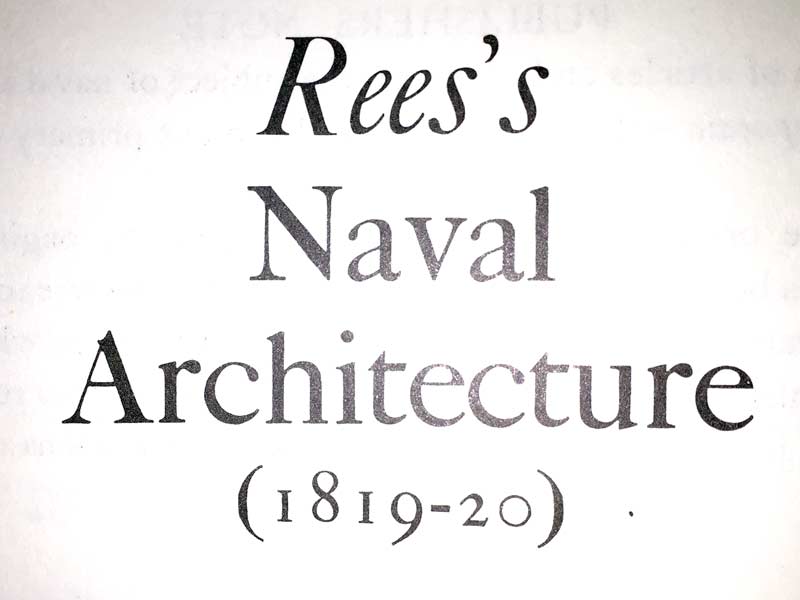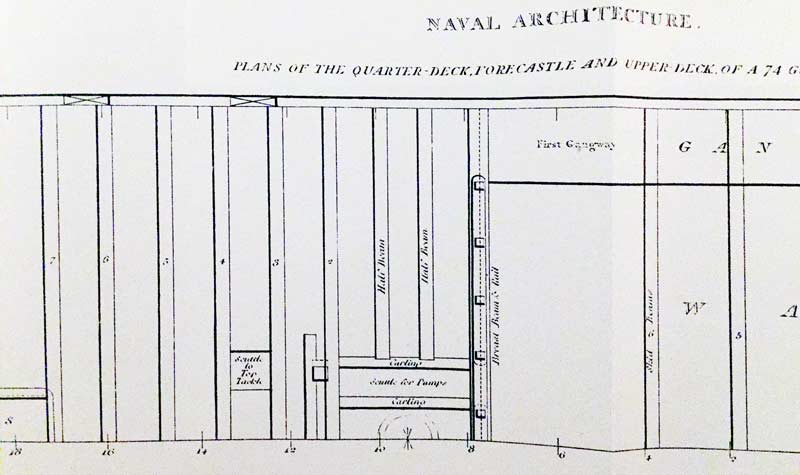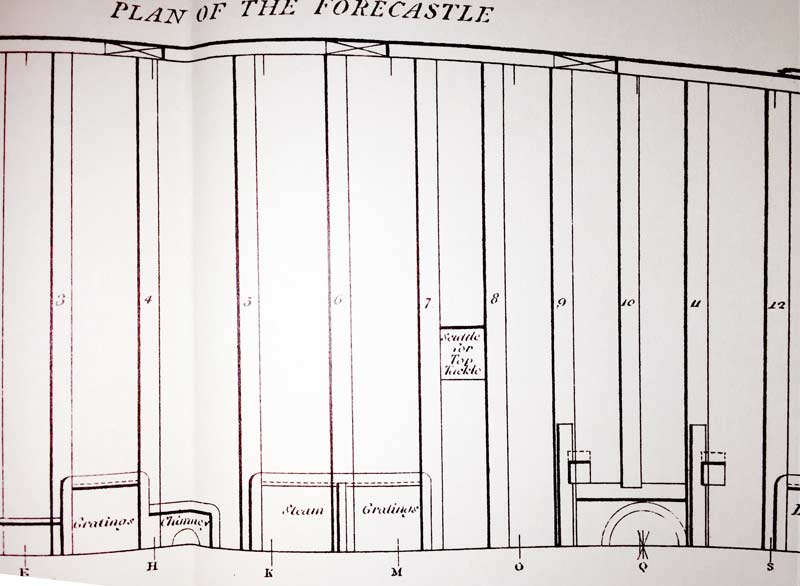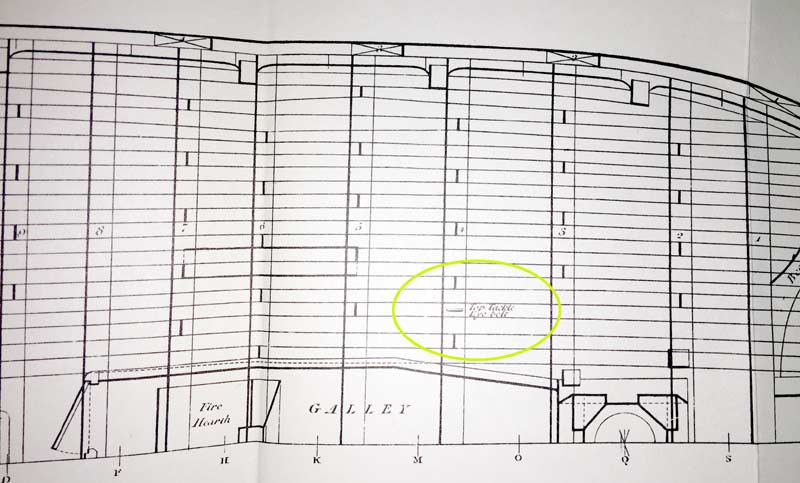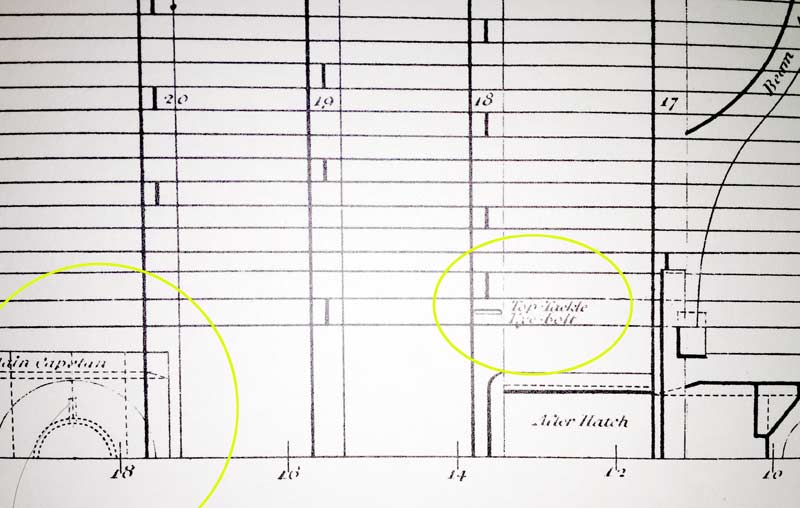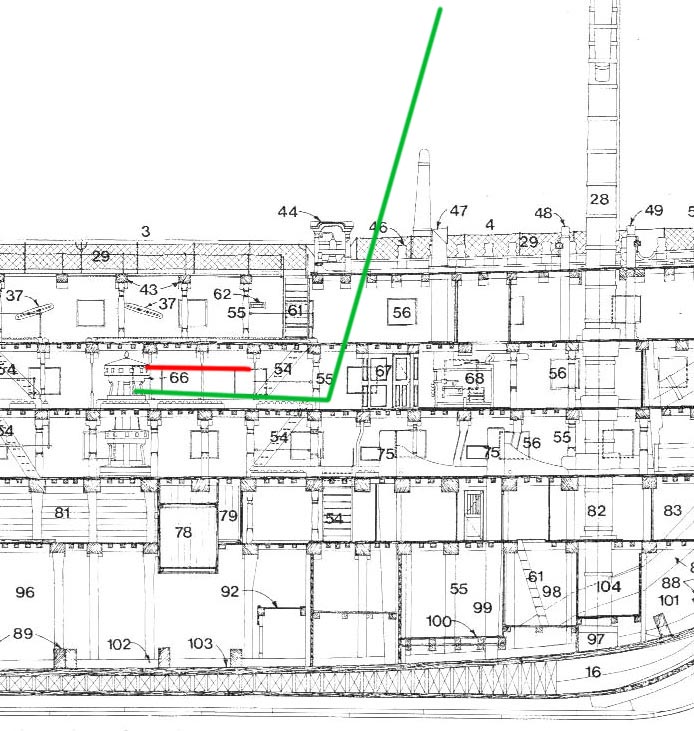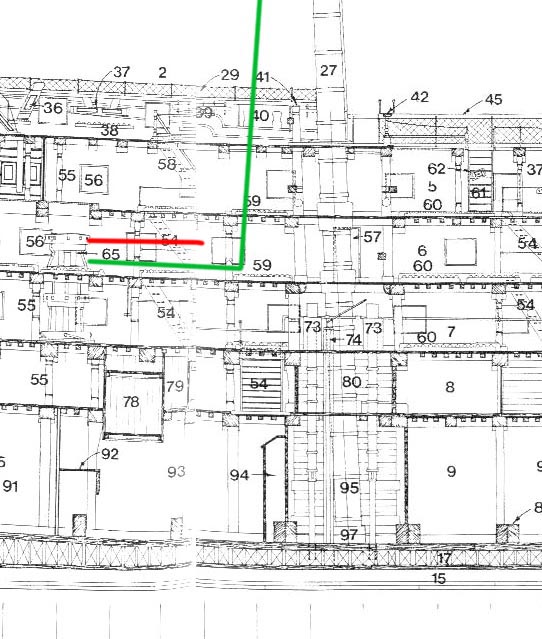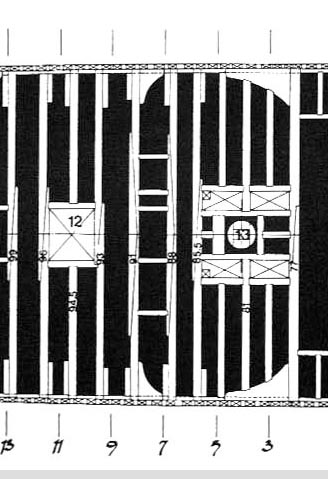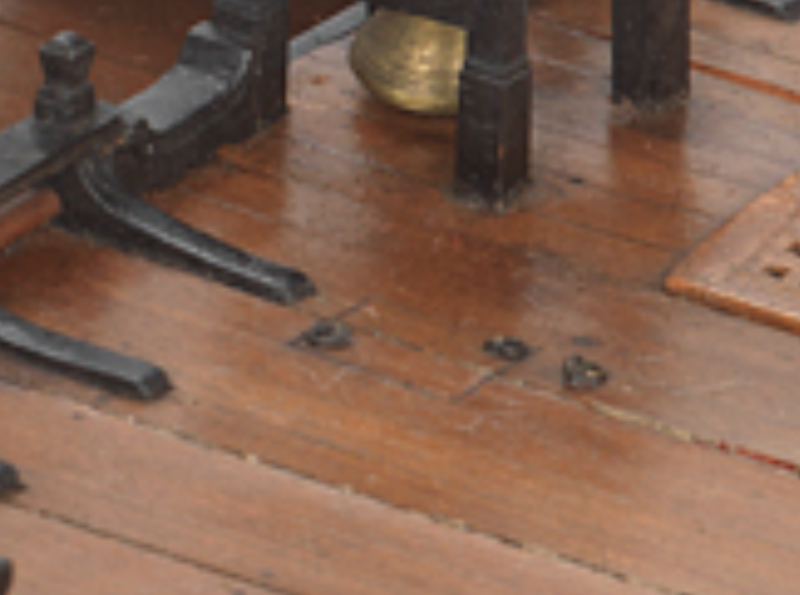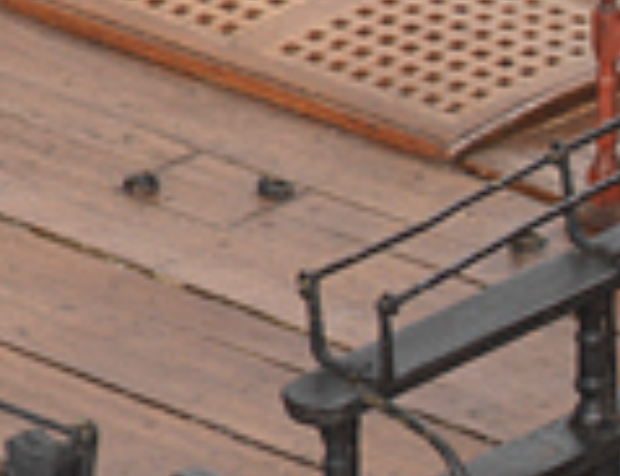-
Posts
2,417 -
Joined
-
Last visited
Content Type
Profiles
Forums
Gallery
Events
Everything posted by dafi
-
A tad longer my dear Jan, a tad longer :-) That is how the gun deck looked in 2010! As my dear wife says: Did not change too much, did it?!? XXXDAn
-
There are plenty of these systems for fresh water shown in modern compilations and contemporary sources as seen in #40 and in NMM. Some come through the bottom, some come through the sides, some straight into the pump, some filling up a cistern and being pumped from there. And if one looks at all the links here in NMM about the heads and other fecal facilities, one understands, that the fresh water is taken from some way underneath the surface ... In my understanding, the chain pumps were only to evacuate the bilge from normal drainage, condensation and normal leaks and of course emergencies. But back to my mystery of the middle deck chain pumps: The "normal" chain pump for two deckers and lesser ships is quite well documented, as there were hundreds of them being in use. First and second rates were only about 30 in the whole time from 1760 to the end of the era. So that could explain the lack of hints about these "phenomena".
-
Thank you Druxey, but this is what I still doubt. The chain pumps are for the bilge water, and this - in my humble opinion - is not really suitable for cleaning. On top the chain pumps do not give water with pressure, essential for fire fighting with a hose. Both Fresh water and water with pressure can be given by the elm tree pumps, getting their Water from the outside of the hull. So still it remains a mystery to me, why the Princess Royal and many later drawings show cisterns in the middle deck, while early plans show just a part that could be interpreted as a cogwheel with handle. XXXDAn
-
Thank you Walter for your input. If the handles of the crank shaft in the lower gun deck have to be given up, I do strongly believe, that the ship is really lost beyond hope :-) As you state the strongest guess for the upper handle is to have more men handling it. Other reasons are still not yet to be seen, as there seems to be enough fresh water pumps for washing and fire fighting. Just rediscovered this topic as in another place there was another discussion about it and this seemed a good idea to check if any new resources popped up to this topic :-) Cheers, Daniel
-
Thank you Sirs for comments and likes! After the model makers meeting in march I originally wanted to tidy up the anchor handling presentation, in the meantime stumbled over the top-tackle scutles, so it is time to link the both. For this I need the pendants from the tops, so time to look for that ... So first step to worm, smart and serve the rope ... ... bound the loop, threw it over the mast top ... ... and let ot a big scream as the binding was on the half round chock and not underneath ... ...AAAAARRRRGGGGHHHHH... So a longer loop was done and a picture taken for that nobody can say they did not see it properly. And really this time it fits underneath the chock :-). Making the cringles is a mostely easy task and already documented some time ago ... ... oup there the 1 mm tube from the old tests, now the slight thicker one of 1,3 mm :-) But then turning the cringles in, thaaaaat is something different ... Left the first trial, right the newer one, I think some more 2716 pieces and the result will be fine And the pendants in place :-) :-) XXXDAn
-
And following the disaster end of August I proudly declare that Captn Hardy ... ... has the ceiling of his cabin finally repainted :-) And the forecastle is done too :-) :-) ... and some more beauty shots from the kitchen :-) :-) :-) The pikes are only on one side of the mast as the main stay is passing on starboard. XXXDAn
-
Thank you Sirs! As a small sign of life, I did some parts that look easier than the way I wanted them to do :-) The gunwale from fo´castle to waist, the on-molded partners needed to be replaced. In P. they have to rolls for some running rigging incorporated, so that was a "wannahavethat2" ... ...ok, once in the mind, never to leave again. Made a green master, that far that good, but ... ... to get 2 fitting holes into that thin structure proved quite a task. Some pre drilling in 0,25 mm and finalizing with 0,3 mm and the holes were through ... ... and still fitting a base underneath the circular section that houses the spare spars ... ... and then the exciting moment ... ... of the mock rigging, and it worked, the rope went through. XXXDAn
-
For me the best is "The voices of the battle of Trafalgar", a collection of plenty of letters written in the days or hours before an after the battle. https://www.amazon.com/Voices-Battle-Trafalgar-Peter-Warwick/dp/0715325566/ref=sr_1_1?ie=UTF8&qid=1478626444&sr=8-1&keywords=voices+of+trafalgar XXXDan
-

Wood masts for a plastic model... Tips?
dafi replied to SomethingIsFishy's topic in Plastic model kits
Here is a test I did a while ago with Heller Victory´s plastic jib and a replacement wooden one of the same dimensions. Both having the same weight hanging on, does one have to say more? Cheers, Daniel -
Lost in time ... and found :-) In ... Exactely on the same spot as seen on the model of the Vic, this time on a british 74, signed as "Scuttle to Top Tackle" And even better, the expected "Top Tackle Eye Bolt" is also shown, at the right distance to the capstan :-) Both finds are 50 years apart, does this mean, that this feature was common for quite a while? XXXDAn
-
Actually ... ... some parts out of this box already ended up on other builders Vics :-) XXXDAn
-

US Brig Syren by Gahm - Model Shipways
dafi replied to Gahm's topic in - Kit build logs for subjects built from 1801 - 1850
Simply love what I see :-) XXXDAn -
@ Jan This is material to do with flower decorations, parcels, wedding dresses and this kind of stuff. A forum mate in the german forum found it and I got a whole role for use with my etch parts. @ Thank you popeye :-) But I think that would be too emotional for me ;-) The belaying pins are on base of Phillip Reed, always worth to have a close look at his technics. XXXDAn
-
In March 2012 I did the fore top to try out the first material for the nettings. And also a small provocation. I placed the lantern not in the main top but in the fore top as indicated by Lavery as Nelson was only Vice Admiral. But by now I have enough contemporary sources that indicate the "classical" version. By now it was time to do the two missing tops. Also I was using the new netting that I deliver together with my etch parts. So I did the wire frame, glued the netting onto it, brushed the paint onto the material and sticked it into place. To get the length of the holding line I used a tooth pick and a cheap thread :-) And then, the surprise, the new netting appears even thinner than the old material, an effect that I liked a lot. And yes, that is why the old netting had to go. And in the box with the discarded parts we go :-) XXXDAn PS: And yes, the opportunity was taken to bring back the lantern onto the main top :-)
-
In NMM I discovered 2 pair of scuttles on the deck of Victory SLR0512 as planned/build. One pair is behind the foremast, near the waist and one on the quarterdeck a bit aft the mainmast. They are fitted each wich a pair of ringbolts. What was their purpose?!? As they have a certain regular distance to the mast and by the way they are paired, my best and well educated guess is that they are to pass the ropes to the capstans on the lower decks. Pass through for ammunition seems not as plausible in this setup http://collections.rmg.co.uk/collections/objects/66473.html SLR0512 Scale: 1:60. A model of H.M.S Victory (1765) made entirely in wood that has been painted in realistic colours with metal fittings. [...] Date made Mid-18th century Even though the resolution is not too good on the pictures of the model of the Royal George (1756) it could be, that there also is something. Does anybody have better pictures? http://collections.rmg.co.uk/collections/objects/66297.htmlSLR0336 If one looks at the section, the position makes sense. The capstan in the foremast works well with the bars kept free ... ... and also explains that the scuttles have to be closer to the mainmast. Funnily McKay also indicate some special feature in this area of the deck framing. Any more enlightenment or confirmation of this theory?!? Are there any other models or sources indicating this detail? XXXDAn XXXDA
-
Just found this at NMM, showing the detail on the Queen Charlotte 1789 :-) http://collections.rmg.co.uk/collections/objects/66516.html SLR0555 Scale: 1:60. A contemporary full hull model of the three-decker 100-gun first-rate ‘Queen Charlotte’ built plank on frame in the ‘Georgian’ style. The quality and finish of the model is exceptional both in the construction and the lavish carved and painted decoration. The ‘Queen Charlotte’ was launched at Chatham Royal Dockyard in 1789 and measured 190 feet along the gun deck by 52 feet in the beam and had tonnage of 2278. She was Lord Howe’s flagship at the Battle of the First of June in 1794 and also took part in Lord Bridport’s action off Croix in 1795. She was accidentally set alight off Leghorn in 1800 with the loss of nearly 700 lives. Date made circa 1789
-
By contrast to what Lil´Wife says, the dafi is teachable. In deed! This time the deck beams for the fore castle are prebent :-) A simplified deck pattern, looks good immediately. Still found some material for two rows of planking ... ... and the two small scuttles that can be seen on the 1765 model. XXXDAn
-
@Jan + Kevin Anyway too easy ;-) I wait until the middle deck is done, then I decide to do the orlop and after this, once lower, middle and upper gun deck is done, I will decide to do the hold :-) So, everybody happy now ?!? :-) :-) :-) XXXDAn
About us
Modelshipworld - Advancing Ship Modeling through Research
SSL Secured
Your security is important for us so this Website is SSL-Secured
NRG Mailing Address
Nautical Research Guild
237 South Lincoln Street
Westmont IL, 60559-1917
Model Ship World ® and the MSW logo are Registered Trademarks, and belong to the Nautical Research Guild (United States Patent and Trademark Office: No. 6,929,264 & No. 6,929,274, registered Dec. 20, 2022)
Helpful Links
About the NRG
If you enjoy building ship models that are historically accurate as well as beautiful, then The Nautical Research Guild (NRG) is just right for you.
The Guild is a non-profit educational organization whose mission is to “Advance Ship Modeling Through Research”. We provide support to our members in their efforts to raise the quality of their model ships.
The Nautical Research Guild has published our world-renowned quarterly magazine, The Nautical Research Journal, since 1955. The pages of the Journal are full of articles by accomplished ship modelers who show you how they create those exquisite details on their models, and by maritime historians who show you the correct details to build. The Journal is available in both print and digital editions. Go to the NRG web site (www.thenrg.org) to download a complimentary digital copy of the Journal. The NRG also publishes plan sets, books and compilations of back issues of the Journal and the former Ships in Scale and Model Ship Builder magazines.



